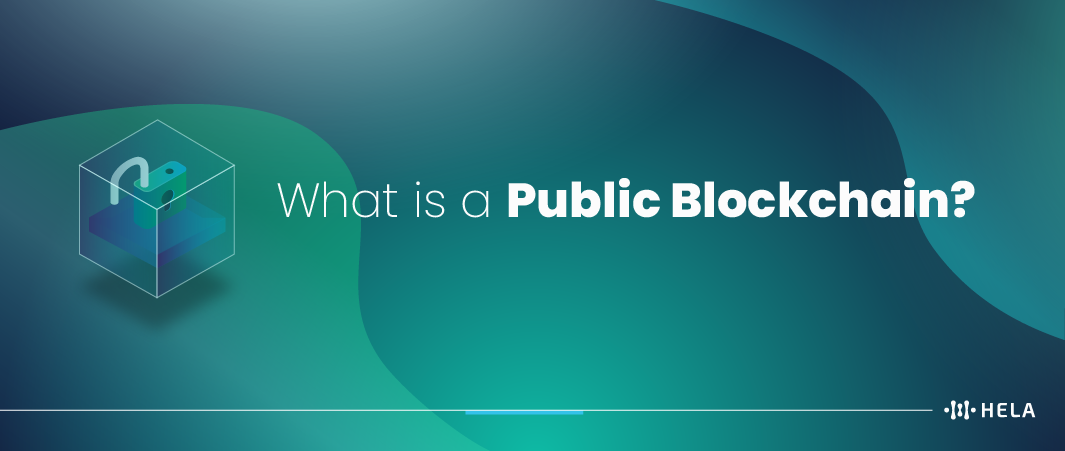In today’s digital age, the term “blockchain” has become synonymous with innovation and transformation. But what exactly is a public blockchain, and why is it considered the gateway to decentralized innovation? In this article, we will delve deep into the world of public blockchains, exploring their fundamental concepts, how they work, and the role they play in shaping the future of technology and finance.
Public blockchains, often referred to as “open” or “permissionless” blockchains, are at the forefront of the cryptocurrency revolution. These decentralized networks have gained significant attention and popularity due to their transparent and trustless nature. In the following sections, we’ll break down the key aspects of public blockchains and shed light on their transformative potential.
What is a Public Blockchain?
A public blockchain is like a digital public square where everyone is invited to join without needing special permission. It’s a type of decentralized system that keeps track of transactions in a way that’s open and accessible to anyone. Unlike private blockchains that have restricted access, public blockchains are open to the public, making them truly decentralized.
In these networks, people from all walks of life come together to validate and record transactions, and they do this through something called a consensus mechanism. This is like a digital voting system where everyone has a say in confirming and securing the information. The idea is to ensure that the data is trustworthy and secure. So, in a nutshell, public blockchains are like the town square of the digital world, where everyone can participate in keeping track of things in a transparent and secure way.
Also Read: What is Litepaper? A Step-by-Step Beginner’s Guide to Writing and Formatting
How Public Blockchains Work
Public blockchains are decentralized networks that enable the secure and transparent recording of transactions. They operate on a peer-to-peer network, where participants (nodes) maintain a shared and immutable ledger. This ledger, often referred to as the blockchain, consists of a chain of blocks, each containing a list of transactions. Here’s a more detailed breakdown of how public blockchains work:
Decentralization
Unlike traditional centralized systems, public blockchains distribute control and authority among a network of nodes. These nodes work together to reach a consensus on the state of the blockchain. This decentralization makes public blockchains resistant to censorship and tampering.
Consensus Mechanism
To agree on the validity of transactions and the state of the blockchain, nodes use a consensus mechanism. Common mechanisms include Proof of Work (PoW) and Proof of Stake (PoS). PoW requires participants to solve complex mathematical problems, while PoS relies on validators who stake cryptocurrency to confirm transactions and create new blocks.
Cryptographic Security
Transactions on public blockchains are secured using cryptographic techniques. Each participant has a private key for signing transactions, and the network uses public keys to verify these signatures. Additionally, the use of hash functions ensures the integrity of the data within each block.
Smart Contracts
Public blockchains often support smart contracts, which are self-executing contracts with the terms of the agreement directly written into code. Smart contracts automatically enforce and execute the terms when predefined conditions are met. This feature enhances the functionality and programmability of the blockchain.
Immutable Ledger
Once a block is added to the blockchain, it is almost impossible to alter or delete the information within it. The immutability of the ledger is achieved through the cryptographic linking of blocks and the consensus mechanism, providing a high level of trust in the recorded data.
Transparent and Open
Public blockchains are transparent, allowing anyone to view the entire transaction history. This transparency fosters trust among participants, as they can independently verify transactions. Anyone can join the network, validate transactions, and participate in the consensus process.
Token Economy
Many public blockchains have their native cryptocurrency or token. These tokens often serve various purposes, such as paying for transaction fees, participating in governance, or representing assets on the blockchain.
Network Upgrades
Public blockchains can evolve through consensus-driven upgrades. Participants decide on changes to the protocol, such as adding new features or improving scalability. This democratic process helps keep the blockchain adaptable to changing technological needs.
Public blockchains leverage decentralization, consensus mechanisms, cryptography, and transparency to create a secure and trustless environment for recording and verifying transactions. These features make them suitable for various applications, from financial transactions to supply chain management and beyond.
Also Read: Consortium Blockchain Explored: An Insider’s Guide to Its Standout Features
Benefits of Public Blockchains

Public blockchains offer a multitude of advantages that make them appealing for various use cases:
Decentralization
Public blockchains operate on a decentralized network of nodes, eliminating the need for a central authority. This decentralization enhances security, as there is no single point of failure susceptible to attacks or manipulation.
Transparency
Transactions on public blockchains are visible to all participants in the network. This transparency fosters trust among users, as they can independently verify and validate transactions without relying on a central entity.
Immutability
Once data is recorded on a public blockchain, it is extremely difficult to alter or delete. The consensus mechanism used in public blockchains, often proof-of-work or proof-of-stake, ensures that all participants agree on the state of the ledger, adding a layer of security and immutability to the recorded data.
Censorship Resistance
Public blockchains are resistant to censorship, as there is no central authority that can control or restrict access to the network. This makes them particularly useful in scenarios where freedom of access and expression is crucial, such as in financial systems or communication networks.
Incentive Structures
Many public blockchains utilize native tokens or cryptocurrencies to incentivize participants, such as miners or validators, to contribute to the network’s security and functionality. This incentive structure promotes network growth and participation.
Global Accessibility
Public blockchains are accessible to anyone with an internet connection, fostering inclusivity and global participation. This feature is especially beneficial for individuals who may be excluded from traditional financial systems due to geographical or socio-economic factors.
Smart Contracts
Public blockchains often support smart contracts, self-executing contracts with the terms of the agreement directly written into code. This enables automated and trustless execution of predefined conditions, reducing the need for intermediaries in various processes.
Interoperability
Public blockchains can interact with each other, promoting interoperability between different blockchain networks. This feature facilitates the seamless transfer of assets and information across various platforms, enhancing the overall efficiency of the decentralized ecosystem.
Community Governance
Many public blockchains involve their communities in decision-making processes through on-chain governance mechanisms. This democratic approach empowers users to propose and vote on changes, ensuring a more inclusive and responsive development environment.
Open Source Development
Public blockchains often have open-source codebases, allowing developers worldwide to contribute to the network’s improvement. This collaborative nature fosters innovation and helps address potential vulnerabilities more effectively through a diverse pool of contributors.
Public Blockchains in Practice

Public blockchains, such as Ethereum, have revolutionized the way we conceptualize and implement decentralized technologies. Beyond serving as the infrastructure for cryptocurrencies, these blockchains have become the backbone for a wide array of innovative applications in practice.
Decentralized applications (DApps) have emerged as a prominent use case for public blockchains. These applications operate on a peer-to-peer network, eliminating the need for intermediaries and providing users with greater control over their data and transactions. DApps cover a broad spectrum of industries, including finance, supply chain, healthcare, and social networking.
Smart contracts, a groundbreaking feature introduced by Ethereum, play a pivotal role in the functionality of these decentralized applications. These self-executing contracts encode the terms and conditions of an agreement, automating the execution of actions when predefined conditions are met. This not only streamlines processes but also fosters a trustless environment where parties can engage in transactions without relying on a centralized authority.
The versatility of public blockchains has led to the creation of diverse ecosystems. Developers worldwide are actively exploring and harnessing the potential of blockchain technology to build innovative solutions. In the financial sector, decentralized finance (DeFi) applications leverage smart contracts to offer services such as lending, borrowing, and trading without the need for traditional intermediaries like banks.
Furthermore, the gaming industry has witnessed a paradigm shift with the integration of public blockchains. Blockchain-based games often feature unique tokenized assets, enabling players to truly own and trade in-game items. This has opened up new avenues for the creation of virtual economies and has sparked the concept of play-to-earn, where gamers can earn cryptocurrency by participating in and contributing to virtual worlds.
As public blockchains continue to evolve, their impact extends beyond the realm of technology. They are reshaping traditional business models, fostering innovation, and contributing to the development of a more transparent and decentralized digital landscape. The exploration of blockchain’s potential in diverse sectors is an ongoing journey, with continuous advancements and real-world applications continuing to shape the future of this transformative technology.
The Future of Decentralized Innovation

The future of decentralized innovation looks pretty exciting as public blockchains keep growing up. They’re not just digital currencies anymore. These things are changing how we do a bunch of stuff, like making supply chains smoother or fixing how we vote. It’s like a big deal for all sorts of industries. Public blockchains, you know, those decentralized networks, are letting regular people and communities get in on the action. It’s like a worldwide creativity and innovation party.
As these public blockchains keep getting better, they’re shaking things up in industries we didn’t even think about before. Like, they’re not just for crypto nerds anymore. They’re helping businesses manage their stuff better and making sure our votes actually count. The whole idea of these networks being decentralized means everyone gets a say, not just a few big shots. It’s like giving power to the people, but in the tech world.
Imagine a future where anyone, no matter where they are, can be part of this global innovation thing. That’s what these public blockchains are aiming for. They’re letting people from all over join in and bring their ideas to the table. It’s not just about changing how we use technology; it’s about making sure everyone can be a part of the change. So, buckle up because the future is looking like a pretty wild ride, and everyone’s invited to the party.
Conclusion
In conclusion, a public blockchain is more than just a technological marvel; it’s a gateway to decentralized innovation that holds the potential to revolutionize various industries. These open, permissionless networks not only provide a secure and transparent ledger for cryptocurrencies but also offer a foundation for building decentralized applications (DApps) and smart contracts. The impact of public blockchains extends beyond finance, reaching into sectors such as healthcare, supply chain, and governance.
The decentralized nature of public blockchains mitigates the risk of a single point of failure, making them resilient and resistant to censorship. This characteristic, coupled with the immutability of the blockchain, fosters an environment of trust that transcends traditional systems. As we witness the evolution of these decentralized ecosystems, we see the emergence of novel governance models and consensus mechanisms that challenge the status quo.
Moreover, public blockchains empower individuals by providing financial inclusion to the unbanked, enabling secure and direct peer-to-peer transactions, and offering a level playing field for innovation. The rise of decentralized finance (DeFi) on public blockchains exemplifies how these technologies are reshaping the traditional financial landscape, providing alternative solutions for lending, borrowing, and trading without the need for intermediaries.
As we navigate the ever-evolving digital landscape, understanding public blockchains becomes essential not only for cryptocurrency enthusiasts but also for businesses, policymakers, and technologists. Embracing the decentralized revolution means exploring the limitless possibilities that public blockchains offer, from creating decentralized autonomous organizations (DAOs) to fostering a more inclusive and transparent global economy.
In essence, public blockchains are not just a glimpse into the future; they are the catalysts for a paradigm shift in how we conceptualize trust, transparency, and innovation. So, whether you are actively engaged in the world of blockchain or simply curious about the future of technology, embracing and learning about public blockchains is an investment in understanding the foundational technologies that will shape our interconnected digital future.
Disclaimer: The information provided by HeLa Labs in this article is intended for general informational purposes and does not reflect the company’s opinion. It is not intended as investment advice or recommendations. Readers are strongly advised to conduct their own thorough research and consult with a qualified financial advisor before making any financial decisions.

Joshua Soriano
I am a writer specializing in decentralized systems, digital assets, and Web3 innovation. I develop research-driven explainers, case studies, and thought leadership that connect blockchain infrastructure, smart contract design, and tokenization models to real-world outcomes.
My work focuses on translating complex technical concepts into clear, actionable narratives for builders, businesses, and investors, highlighting transparency, security, and operational efficiency. Each piece blends primary-source research, protocol documentation, and practitioner insights to surface what matters for adoption and risk reduction, helping teams make informed decisions with precise, accessible content.
- Joshua Soriano#molongui-disabled-link
- Joshua Soriano#molongui-disabled-link
- Joshua Soriano#molongui-disabled-link
- Joshua Soriano#molongui-disabled-link

